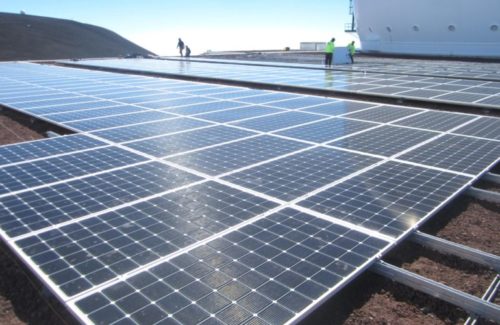High above the beautiful beaches of Hawaii, the W.M. Keck Observatory sits on the upper slopes of the inactive volcano Mauna Kea. The observatory is home to two telescopes designed “to observe the universe with unprecedented power and precision.” The location of Mauna Kea — 14,000 ft high and in the middle of the Pacific Ocean with no nearby mountain ranges and few city lights polluting the night sky — makes it ideal to visually explore the far reaches of space. The telescopes here are among the most visually productive on earth, and Keck Observatory is a destination for astronomers seeking to expand mankind’s knowledge of space.

The observatory and accompanying solar array reside at nearly 14,000 ft above sea level, where UV exposure is pronounced, wind speeds are derated and atmospheric pressure causes a 40% drop in oxygen levels. Credit: Mark Devenot/W.M. Keck Observatory
The location of the Mauna Kea observatory also makes it an ideal location for a solar installation. In the early 2010s, a solar array was installed at Keck’s headquarters, two hours down the mountain at the base of the volcano. Inspired by the success of that first installation, engineers began to ponder the feasibility of installing a solar system at the summit of the volcano. The staff then completed the installation of a 137-kW solar system at Mauna Kea in December 2020.
During the construction, workers removed the ballast from the existing black EPDM roof that had supported the Keck I and Keck II telescopes for more than three decades. The roof ballast, abundant and nearby, was comprised of cinder ejected thousands of years ago from the dormant volcano. After careful review of the EPDM membrane, inspectors said it “appeared brand new” and left it in place.
Then 332 solar panels were strategically placed on the 20,940-ft2 roof, carefully positioned to avoid snow and ice fall from the telescope domes. The roof ballast was replaced after the solar system was installed. Project managers noted that one of the biggest challenges was attaching the PV array to a roof that had no structural framework to anchor the system. This meant designing a one-of-a-kind solution: a customized racking system made of hundreds of large, heavy 1/2-in. steel plates interconnected to a framework of strut materials to which the solar panels can clamp.
Today, the system is producing approximately 10-15% of the observatory’s electrical power, helping to carry out its commitment to reduce the organization’s carbon footprint and lower the cost of energy. The work on Mauna Kea offers lessons that can be applied to less challenging projects. For roofers, the renewed interest in solar — and financial support for it from the federal government — requires roofing systems that can support a solar array and provide a setting where solar panels can be successfully maintained.
In general, any roof that is supporting overburden, whether it is vegetation or solar panels, should clearly be thick and durable. Solar panels will need maintenance and repair, and their placement on a roof must allow for access in case of fire. Roofing-related code provisions increasingly acknowledge this need and require that sufficient space be left between groups of panels to allow for emergency access. Any roofing membrane installed under a solar system needs to be durable enough to withstand this traffic, as well as scheduled maintenance.
Service life is also critically important. Before any construction of a solar installation should proceed, it’s important to ask. “Will the service life of your PV system be similar to the existing or intended roofing membrane?” Solar panels can last beyond three decades. A membrane that wears out before the solar panels need replaced can create an expensive and logistical challenge.
Much has been written during the last decade in the “black vs. white” roof color debate. Growing interest in solar has no doubt impacted this debate. However, current codes stipulate that with much of a roof covered, the color of the membrane and any potential benefit from reflectivity can be negated. In fact, energy conservation codes in Zones 1 through 3 generally exempt roofers from meeting the requirement for reflective roofing, in what is described as “overburden” exemptions. Under model codes, relief from the requirement for the entire roof can be met by covering up to 75% of the roof with PV, vegetative systems, walkways or any combination of these elements. In essence, the code is already acknowledging the fact that in these instances, color doesn’t matter.
Given this leeway provided by energy conservation codes, the durability and longevity of a membrane such as black EPDM argues strongly for its use. As for that EPDM membrane helping to support a PV system high on a mountain above Hawaii, it is going into its fourth decade of service, contributing to a lower electricity bill for unmatched world class research into our galaxy and beyond.






Tell Us What You Think!